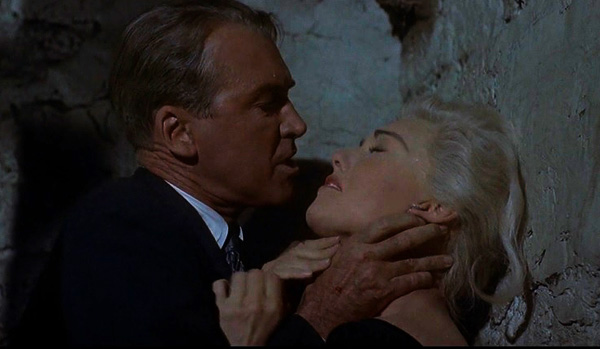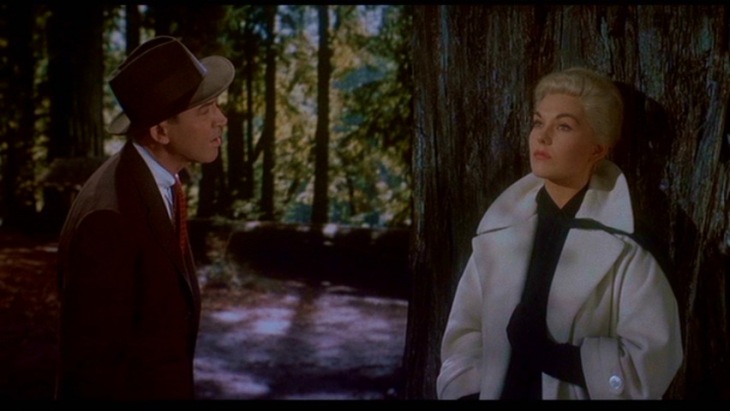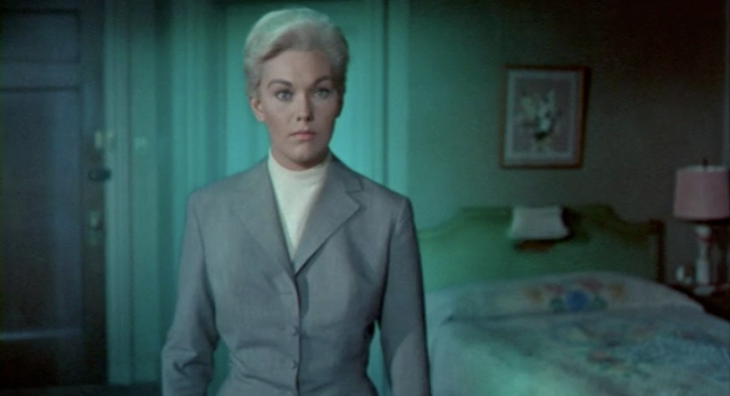Vertigo can seem like a cold, clinical and heavily-plotted film. There is also an argument for viewing it as a darkly romantic and passionate love story. Only here the love is unrequited. Judy Barton (Kim Novak) cannot truly win the love of John ‘Scottie’ Ferguson (James Stewart) because she has tricked him into loving a woman whom he thinks is dead, but who never really existed.
Scottie cannot love Judy because he is obsessively in love with that ghost, and he tricks himself into believing that he can recreate her in Judy. He prefers his dream of a dead woman to a real one, and she cannot confront him with the truth without endangering herself and losing him completely.
Of all Alfred Hitchcock’s movies, Vertigo is the one that comes closest to being a pure arthouse movie. When the movie was a box office failure on its release. Hitchcock unfairly blamed Stewart for being too old for his role, and refused to work with the actor again. However the problem was the film’s lack of commercial appeal.
It preserves the trappings of a thriller, but the story is downbeat. Faced with the choice between pandering to a wider audience and making an aesthetic choice, Hitchcock opted for the latter. It is hardly surprising that despite the film’s inauspicious beginnings, it is now honoured by movie critics as one of the greatest movies of all time.
The plot is nonsensical, but this is appropriate to artificiality of the moviemaking. The story follows a circular pattern. It opens with Scottie and another policeman chasing a criminal across the rooftops. The criminal escapes and the policeman falls to his death. This will not be the last time that we see a criminal escape justice and a body fall from a great height.
The shock of the incident causes Scottie to develop acrophobia and vertigo, and he is obliged to quit the police force. He is told that only another shock will cure him. Incidentally the movie has been responsible for confusion about the meaning of the word ‘vertigo’. The fear of heights is acrophobia. Vertigo is the accompanying sensation of disorientation.
During this time of leisure Scottie is approached by an old college acquaintance called Gavin Elster (Tom Helmore). Elster wants Scottie to work privately for him trailing his wife, Madeleine (Kim Novak). Scottie follows Madeleine to various locations where she shows a strange obsession with her great-grandmother, Carlotta Valdes, a woman who went mad and committed suicide when she was Madeleine’s age. Elster fears that Madeleine has become possessed by Carlotta.
Scottie’s watching turns into active participation when Madeleine throws herself into the bay at Fort Point, and he rescues her. The two spend time together and fall in love. Scottie takes Madeleine to the childhood town of Carlotta, hoping that this will cure her. Instead tragedy strikes. Madeleine throws herself from the bell tower of a church, and Scottie’s acrophobia and vertigo prevent him from saving her.
Scottie has finally got the shock he needed, but it is not of a kind to cure his condition. The guilt of her death, compounded by a severe dressing-down from the coroner, causes him to lapse into a state of catatonic shock. When he emerges from this state and is released from a sanatorium, he spends his time visiting the places that he saw Madeleine, and seeking out Madeleine’s image in other women.
Finally he gets his wish when he meets a woman who resembles Madeleine. This woman is Judy Barton, and Scottie asks her for a date. In fact, Judy Barton is the Madeleine Elster that Scottie knew. She was posing as Elster’s wife as part of a plot to murder his actual wife. When she ran up to the tower, Elster had already broken his wife’s neck, and he throws her body down instead.
Judy has been ditched by Elster and paid off, but she is safe. She knows she should flee Scottie forever, but Judy is in love with him. She reluctantly allows the obsessed Scottie to alter her looks until she resembles the Madeleine he remembers. However her ‘sentimental’ decision to hold onto one of Madeleine’s necklaces gives her away. Scottie takes her to the bell tower and confronts her with her guilt. They are startled by an apparition in the gloom (it is a nun), and the guilt-ridden Judy falls from the tower. The pattern has been repeated again.

Vertigo is a movie that pays repeated watching, and is actually better on a second viewing. On our first sitting, we spend a long time concentrating on the mysterious plot, trying to work out what is going on. The second time around we know how the story develops, and this deepens our understanding of the earlier scenes.
For example, we can now see the extent to which Scottie is being duped and manipulated by Elster and Judy. When Scottie trails Judy, we notice that she pauses long enough for him to see her, or to catch up with her. Later she chooses her actions and words carefully in order to set up the Carlotta Valdes story that will supposedly ‘explain’ her apparent suicide later. We recognise the humbug of Elster as he expresses his concerns about his wife’s imaginary obsession. We understand why he chose Scottie, a man whose acrophobia can be exploited.
Each viewing of Vertigo allows us to notice the extraordinary parallels between the first part of the story (Scottie and Madeleine) and the second part (Scottie and Judy). There are many of these, and some are minute. I will name just a few. Both sections open with Scottie recovering from an incident where someone fell from a height. He is in a room with his friend Midge (Barbara Bel Geddes), and she is playing classical music.
Both parts of the movie show him revisiting the same places – Madeleine’s home, the restaurant he first saw her in, the art gallery the grave of Carlotta etc. Later he dresses Judy up as Madeleine just as Elster did. There is a ride to Carlotta’s old town, a kiss in which the camera seems to revolve around the characters, and a visit to the bell tower ending in the death of a woman.
These parallels establish the circular and self-defeating pattern of Scottie’s behaviour, doomed to repeat his previous mistakes. Notably the credits to the movie also contain rotating circles. In asking Judy to dress up as Madeleine, Scottie is doing exactly the same thing to her that Gavin Elster did. Both use Judy for their own ends, and neither loves her for herself. The two men’s motives are opposites. Elster uses Judy so that he can murder his wife. Scottie uses Judy so that he can bring Elster’s wife back to life.
We should also mention a third person who seeks to recreate Madeleine. This is Midge, the sensible friend who is obviously in love with Scottie, but whom he can’t see due to his fascination with Madeleine. She too recreates herself in another woman’s image, but in her case it is the painting based of Carlotta Valdes. This joke misfires badly however, and Scottie never speaks to her again in the film.
Hitchcock explained the plot of Vertigo to fellow moviemaker Francois Truffaut in the following terms: “To put it plainly, the man wants to go to bed with a woman who is dead.” Indeed many people have described the plot as necrophiliac. Such a description is partly true, but the reality is even more complicated than that.
It might be simpler to argue that the movie is about the influence that the dead have over the living. Death permeates the story of Vertigo. Scenes take place in a graveyard. A visit to a woods filled with sequoia serves emphasises the contrast between the ever-living trees and the brief mortality of humans. The nun at the end of the movie rises like a deathly spectre.

Scottie wishes to recreate Madeleine because of his guilt at failing to save her. During the first half of the movie when he is comparatively healthy in his mind, Scottie behaves like a psychoanalyst to Madeleine, as he seeks to remove her seeming possession by a dead woman. He probes her, observes her, questions her, seeks to interpret her dreams. This attempt to cure Madeleine is doomed to failure because the answers he receives are lies.
In the movie’s second half, he concentrates on curing himself. Only this time it is he who is genuinely possessed by a woman whom he believes to be dead. Once he realises that Madeleine and Judy are the same woman, he feels that he has a second chance to get to the truth. Scottie thinks that he can heal himself by confronting Judy. To a degree he succeeds. He successfully overcomes his acrophobia and makes it to the top of the bell tower. He is able to look down from the tower after Judy falls. However the movie ends before we can tell whether Scottie is a whole man now.
Scottie also seeks to recreate Madeleine because the thinks that he is in love with her. However he is not in love with a flesh-and-blood woman, but with the image of one. When we look at Scottie’s activities in the first part of the movie, they are of a voyeuristic nature. He follows Madeleine around everywhere and watches what she does.
A third of the movie is over before Madeleine speaks a line of dialogue. Scottie talks to her on three occasions before her apparent death, and each time he is only seeing a woman who is impersonating her. Scottie never really knows Madeleine, not even if she was a real person. He loves a fantasy image only.
When he meets Judy Barton, Scottie has no interest in her for herself. He does not care about her thoughts or feelings. He can barely even look at Judy. He wants only an image of the dead woman. Scottie immediately begins to take over Judy’s life. He stops her from working for a living, and asks her to spend her days with him.
Next they visit clothes shops and Scottie pressures Judy into choosing clothes that are the exact match of the ones she wore while posing as Madeleine. He forces her to style her hair in the same manner, down to the last curl. He overrides her protestations with utter insensitivity. “It can’t make that much difference to you.” “It can’t matter to you.”
He is only satisfied when she makes the last change that turns her into the identical image of Madeleine. Standing in the neon light of her room, Judy looks as if she is bathed in a green mist as she approaches Scottie like a ghost. Scottie has brought the dead back to life, if only for a short time.

Hitchcock reveals the truth about Elster and Judy’s deception immediately after Scottie’s meeting with Judy so that we can identify with Judy’s plight. She may have participated in a murder, but she is suffering. She is miserable and wants to leave, but she is just as caught up in the tangled web as he is. Judy changes so that he will love her a little, even though she knows that he really does not. It is just when she thinks that she has finally won him that Scottie notices her necklace, and suddenly she has lost him again.
The movie works as a metaphor for the movie industry. Like Judy Barton, actresses are dressed and styled to meet a male construction of ideal femininity, and they are not allowed the chance to be themselves. In this sense, the movie is Hitchcock’s most autobiographical. He too was obsessed with his lead actresses, and sought to turn them into an idealised woman – the fascinating and perfectly-dressed and coiffed blonde.
However this archetype of perfect womanhood could never be sustained for long, and soon the blonde will be punished for her icy aloofness. She will fall from a bell tower, be stabbed to death in a shower or attacked by birds. We could almost see it as the rage of a man against his unobtainable ideal of womanhood.
One reason the movie was initially unpopular may have been that audiences could not warm to the idea of James Stewart playing a darker role than usual. Indeed even lovers of the movie condemn Scottie’s behaviour towards Judy. Scottie certainly does treat Judy badly, but there are a few mitigating factors. Scottie acts in this manner because he is sick. What he does to Judy is not nearly as bad as what Elster and Judy do to him. They kills a woman and destroy a man’s psychological health for money.
Elster is the bigger offender. He exploits both Judy and Scottie. Elster too is caught in the past. He longs for the old San Francisco where men had “the power and the freedom” to do as they liked. This power is of the same kind as the rich man who abandoned Carlotta Valdes, causing her to go insane. Elster too uses his power for bad ends and ditches a woman when he has no further use for her.
The greater victim though is Scottie. He is trapped in a pattern of self-defeating behaviour as a result of what is done to him, and he is unable to help himself. After his release from the sanatorium, he passes a one-way sign on his way to Madeleine’s house, and we infer the sickening inevitability of his choices. While he claims to have found happiness with Judy, their romance is a stiff one, and he never smiles again.
In order to convey the confusion of psychological motivations and outright deception, Hitchcock used as many disorientating methods as he could. Vertigo marked the first use of a dolly zoom camera effect that helps to distort perspective and make heights seem greater. The movie included another innovation – the use of computer graphics in a sequence where Scottie has a nightmare. Nowadays the graphics seem a little out of place in the film, but this was a first attempt at trying something new.
In a scene where the two lead stars kiss, the actors were rotated to create a swirling perspective, and the background changes to one seen in earlier in the movie to show how they are stuck in the past. Many scenes are permeated by the dizzying and haunting Bernard Herrmann music score.
Other actions also serve to disorientate the viewer. There is the shock of seeing the movie’s heroine apparently killed off after only an hour and a quarter of the movie has passed. There is the casting of the usually affable James Stewart in a colder role than usual. There is the grey and constricting dress that seems to fit so ill with Kim Novak’s blonde hair.
The story has some loose ends and improbabilities. Elster’s scheme for killing his wife is too elaborate and relies on too many chances to be believable. The scene where Madeleine enters a hotel and is not seen by the staff is never satisfactorily explained. Midge disappears from the movie after visiting the sanatorium, and Elster apparently gets away with his crime.
However these untidy elements do not detract from a film that is not only Hitchcock’s best film but possibly the greatest movie ever made.

14 thoughts on “Vertigo (1958)”